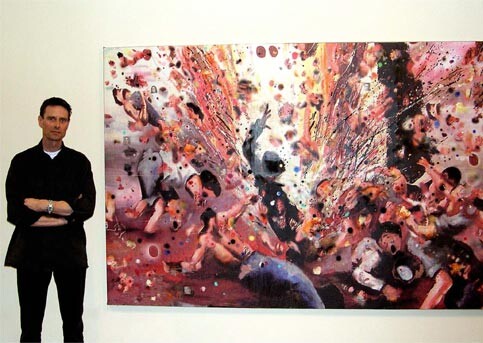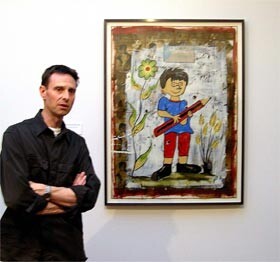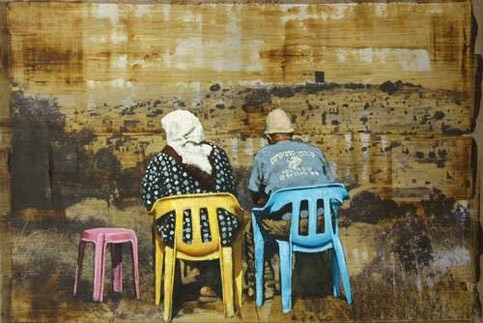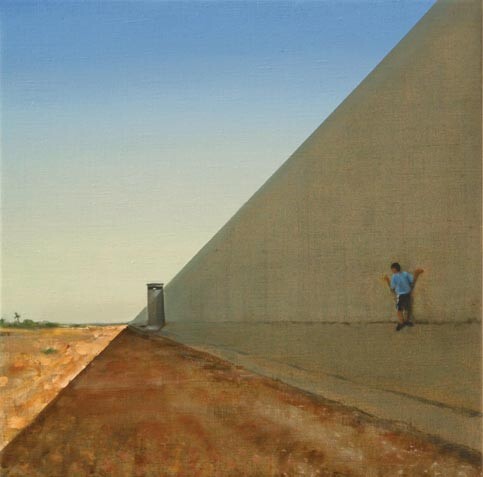The Electronic Intifada 5 March 2004

John Keane with his painting “The Moment”
Body parts fly across a red canvas depicting the suicide bombing of the Moment Cafe in Jerusalem. “The Moment,” the most harrowing of John Keane’s paintings from Palestine-Israel, is hung in the most prominent place in the traveling exhibition The Inconvenience of History - Paintings from the West Bank and Palestine, currently showing at the London Institute. Another painting, “Ramallah, Ramallah,” shows two bloodstained hands in the window of the Ramallah police station where two Israeli reservists were torn into pieces by a mob.
Keane, currently a visiting professor at the London Institute and visiting research fellow at the Camberwell College of Arts, said the exhibition had been well received. The Board of the Deputies of Jews in Britain, however, protested to Christian Aid — the sponsors of Keane’s two trips to the Holy Land — and asked the show to be withdrawn. The exhibition was biased, did not depict Israeli suffering and tried to legitimise Palestinian terror, the board said. Christian Aid stands by its show at the London Institute Gallery. “It is certainly true there is an emphasis on the Palestinian point of view,” a Christian Aid spokeswoman told the Times newspaper in London. “This is mainly because we were in the occupied territories. Most of our work in the region is with the Palestinian side because that is where the poverty lies.” Keane said one could argue that the exhibition was more sympathetic to Israel.
The majority of Keane’s work represents the Palestinian narrative, and in a quiet way conveys the despair, humiliation and the brutality of life under an Israeli occupier ruthlessly segregating the Palestinians. Keane says he wanted to avoid “cliche images” of stone-throwing Palestinians, grieving families, Israeli tanks, bulldozers, fighter planes, and roadblocks. “My focus was on images that appealed to me on a personal basis, images that capture feelings,” Keane said during a presentation of the show.

John Keane with his painting “The School of the Innocent Children 1, Jenin”
At the flattened Jenin refugee camp Keane witnessed the homes reduced to chunks of rubble. A school once overlooked the camp from a hill. Now children’s laughter has stopped and the school is trashed and vandalized. “I was surprised how comprehensively it had been destroyed,” Keane said. “No earthquake could have been as thorough.” But a mural depicting Palestinian school children was left standing. The eyes of the smiling children were gouged.
Throughout his trip, Keane was struck by the systematic way the Israeli army had destroyed Palestinian homes, schools, villages, olive and fruit trees, farmland, water resources, infrastructure in an effort to wipe out any evidence of Palestinian existence.

“The Inconvenience of History” by John Keane
On July 15, 1948, the Palestinian village of Saffuriyya, biblical hometown of Mary’s parents, was depopulated as 4,300 Palestinians fled from their homes. The town was subsequently wiped off of the map. The church of Saffuriyya is said to have been built by Helena, the mother of Roman Emperor Constantine the Great, who converted into Christianity. Keane found no sign of the village. The land had been turned into a park that also commemorates the independence day of Guatemala. Keane juxtaposed an old photo of the village and used it as the basis for a series of paintings he named “The Inconvenience of History.” While Keane’s host had no rights for his family’s land in the village - Israel does not grant Palestinians rights to land - Israel still forces him to pay tax. “Before I can co-exist,” the man told Keane, “I need to exist.”
Saffuriyya was one of the hundreds of villages that Israel razed after its creation. The realization of the fact that Saffuriyya had been obliterated was fundamental for the understanding of what is happening in Palestine, Keane said. “The question is ‘what had been’ instead of ‘what is now.’” To Jewish Israel, “Palestinians are an inconvenience of history, a history they attempt to erase,” Keane said.

“Ismael” by John Keane
Ismael Jaber, a Palestinian farmer outside Hebron where his family has tilled the land for centuries, built water cisterns to irrigate his crops. The Israeli army destroyed them because he did not have — and would not have be given — authorization from the Israeli occupation forces. Keane painted Jaber’s rugged features against a towering Jewish settlement.
Some of the paintings are instantly recognizable to the viewer. “Hopeless in Gaza” portrays the dying moments of 12-year-old Mohammed al-Durrah in the arms of his father, a scene that became the icon of the second intifada. But while on TV screens we saw Mohammed’s father sheltering against a concrete barrel trying to protect his son from Israeli fire, today the Netzarim Junction, the location in the Gaza Strip where Mohammed was killed, is unrecognisable. The barrel was destroyed a few days after his death, along with a shack belonging to Palestinian security forces. Two blocks of flats overlooking the Israeli army camp were razed later to give unhindered view from the watchtowers protecting the nearby settlement. Keane’s layered painting “Hopeless in Gaza” juxtaposes history and present day reality. Mohammad and his father huddle against one another on a wide empty road, a road Palestinians are not allowed on, that leads to the Jewish settlement.

“Security, Impunity, Geometry and Terror”
After half a century of occupation, Israel is now building a wall that confines the Palestinians into enclaves in less than 15 percent of the land of historic Palestine. Keane’s painting “Security, Impunity, Geometry and Terror,” depiciting the wall, is the exhibition’s smallest work but it may be the most powerful. The concrete wall divides the canvas into two. “It cuts the canvas, the air, it describes the nature of the division,” Keane explained. “This brutalist, minimalist sculpture cuts through people’s gardens and groves. Its sheer monumentality makes the Berlin Wall look like a garden fence.”

“No Arabs, No Terror”
At first glance “Armageddon Now” looks like a pretty travel brochure photo with palm trees and sand. But on closer inspection, you distinguish a barely visible helicopter-gunship in the palm-treed horizon of Meggiddo, known in the bible as Armageddon, the site of many ancient slaughters and the mythical place of the final battle between Good and Evil. “ ‘Armageddon Now’ symbolizes the continued failure to find a solution,” Keane said, noting that not only regional and world security were in stake but also humanity due to the religious dimension of the occupation of a land holy to Muslims, Christians and Jews alike.
On his visit to Palestine and Israel, Keane accompanied Christian Aid staff as part of his Research Fellowship at the Camberwell College of Arts. He took video footage and photos of the wreckage left by Israelis and talked to people on both sides of the divide: human rights workers, Jewish settlers and Israeli soldiers, a spokesman for the Jewish community in Hebron, a survivor of a suicide bomb attack in West Jerusalem, people whose homes had been destroyed by the Israeli army, farmers, shopkeepers, mothers, priests.
Back in his studio Keane used his photographs to prepare the paintings and applied photographic inkjet prints and layers of oil paint to the surface of a work. In his work the devastation of the land is punctuated with human life: an evacuee’s colorful clothing, a cartoon-like children’s mural or a plastic chair.
“My visit to Israel and the West Bank left me feeling the utter inadequacy of attempting to convey the reality of daily lives there to anyone who has not witnessed it first-hand,” he said.
Christian Aid says that it did not know the conclusions Keane would draw and that people should be allowed to make up their own minds about the situation they are seeing. “On this trip with John Keane we aimed to provide a spectrum of views across the divides to enable him to come to his own conclusions about life in Israel and the Occupied Territories today.”
Related Links
John Keane - The Inconvenience of History - Paintings from West Bank and Palestine will next travel to Belfast.
London Institute (January 29 to March 11, 2004)
Belfast Naughton Gallery (March 30 to May 12, 2004)
Ramallah, Palestine (June 16 to June 30, 2004)
Derby Museum and Art Gallery (September 4 to October 17, 2004)
Nina Malmsten is a Finnish journalist who lives in London. She can be reached at malmsten579@hotmail.com.

